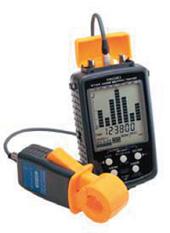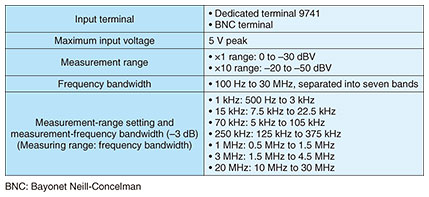 |
|
|
|
|
|
Practical Field Information about Telecommunication Technologies Vol. 20, No. 10, pp. 87–91, Oct. 2022. https://doi.org/10.53829/ntr202210pf1 Case Study of Audible Noise on Analog Leased Lines Caused by Electromagnetic DisturbanceAbstractIf electromagnetic disturbances, which are generated from malfunctioning appliances or radio waves, interfere with metallic cables, it can cause telecommunication failures such as audible noise being heard when using telephones and disconnection of digital subscriber lines. This article provides a case study of audible noise interfering with voice-based services, the cause of the electromagnetic disturbances, and a countermeasure against them. This is the seventy-second article in a series on telecommunication technologies. Keywords: electromagnetic disturbance, PBX, Noise Search Tester 1. IntroductionIf electromagnetic disturbances generated from malfunctioning appliances or radio waves interfere with metallic cables, they can cause telecommunication failures such as audible noise being heard when using telephones, disconnection of digital subscriber lines, and transmission errors on ISDN (integrated services digital network) lines. To resolve such failures, it is necessary to identify the source of the electromagnetic disturbances and eliminate them. This article provides a case study of audible noise interfering with voice-based services, the cause of the electromagnetic disturbances, and a countermeasure against them. 2. Case studyA customer using a 3.4k analog leased line reported that a high-pitched audible noise could be heard when using certain telephones. Though the local telecommunication maintenance personnel applied countermeasures, including changing the line number; the audible noise was not cleared. Therefore, the Technical Assistance and Support Center (TASC), NTT EAST was asked to investigate the problem. 2.1 Configuration of equipment and failure stateThe customer operates their own private branch exchange (PBX) and uses 3.4k analog leased lines between the PBX in the customer’s main building and several offices located in the same city or surrounding areas, for extension calls. The configuration of the equipment is shown in Fig. 1. A redundant configuration is adopted between the customer’s main building (in which the customer’s PBX is installed) and an NTT building (telecommunication central office), having two different telecommunication access routes in the overhead section, so that the 3.4k analog leased lines can be maintained even in the event of a cable failure in the access network section. The route can be switched by changing the jumper cable in the main distribution frame (MDF) in the customer’s main building. There are two routes between the NTT building connecting to the customer’s main building and customer’s offices: (1) a route turning at the MDF in the NTT building and (2) one going through another NTT building in the city.
The customer reported that high-pitched audible noise was being constantly heard through the telephones installed at multiple offices. The results of on-site interviews with the customer revealed that the audible noise was present on four lines. To confirm the details of the noise, on-site telecommunication maintenance personnel investigated all 300 lines installed in the customer’s main building using a cable tester, and it was confirmed that the audible noise was present on 17 lines of the 200-pair cable in use. No audible noise was generated on lines of the other 100-pair cable. As a countermeasure, the telecommunication maintenance personnel changed a line number within the same 200-pair cable, but the audible noise was not cleared, so the cable was switched to the stand-by 100-pair cable in the redundant configuration, and the audible noise was cleared. Because the cause of the audible noise was unknown, and the audible noise was generated again when the route was switched back to the 200-pair cable due to connection failure, etc., TASC was asked to investigate the cause of the audible noise. 2.2 Investigation of the cause of audible noiseTASC first investigated the cause of the audible noise. TASC asked the on-site telecommunication maintenance personnel to check the condition of the equipment and measure the audible noise at the site. On the basis of the results obtained on-site, TASC analyzed the measurement results, determined the cause of the noise from the analysis results, and proposed a countermeasure. (1) Confirmation of frequency characteristics and cycle of the audible noise To confirm the frequency characteristics of the audible noise reported by the customer, it was recorded at the site. The recorded sound files were subjected to First Fourier Transform (FFT) analysis by TASC. The results of this analysis are shown in Fig. 2. It was found that the level of the noise signal was higher at the fundamental frequency (which is approximately 800 Hz) and its harmonics at odd multiples. It was also found that the audible noise was occurring periodically (every 20 to 30 s).
(2) Identification of noise source To identify the lines with the highest audible noise, the voltage levels of the audible noise on 17 lines of the 200-pair cable routed into the customer’s main building were measured. The Noise Search Tester (3144) and its probe, i.e., a voltage sensor (9741), both manufactured by Hioki E.E. Corporation (Photo 1), were applied to measure the common-mode voltage levels of the audible noise at the MDF of the NTT building. The basic specifications of the Noise Search Tester are listed in Table 1. Common-mode voltage levels for seven frequency ranges can be displayed by the tester’s bar indicator.
The measurement results of the lines with the highest common-mode voltage level are shown in Fig. 3. It was found that the highest common-mode voltage level (about –2 dBV) occurred in the 1 kHz band, i.e., voltage level at frequencies between 500 Hz and 1.5 kHz.
Since this frequency range includes 800 Hz, i.e., the fundamental frequency of the recorded sound file, TASC concluded that it corresponds to the common-mode voltage level of the audible noise reported by the customer. It was also found that the common-mode voltage level fluctuates periodically and corresponds to the phenomenon observed by playing back the sound file, i.e., a high-pitched noise (at approximately 800 Hz) occurring periodically every 20 to 30 s. 2.3 Estimation of source of audible noiseThe repetition of the sound at approximately 800 Hz suggests the “howler (off-the-hook) tone” of the PBX. A howler tone is an audible sound transmitted when a telephone is off the hook for an extended period, even though the line is not used. We examined the conditions under which the customer’s PBX transmits a howler tone (Table 2) and found that the frequency, transmission time, and repetitive transmission conditions of the howler tones were almost identical to those of the audible noise identified in the investigation.
Since the PBX in question transmits a howler tone when it detects a loop current of 13 mA or more, the cause of the audible noise is assumed to be faulty insulation on the line connected to the PBX. The cause of the audible noise on multiple lines is assumed due to the deterioration of the balance of the line due to faulty insulation of the line, which induced the howler tone being sent to the line in question to be directed to an adjacent line. 2.4 Verification of countermeasure and its effectivenessThe line with the highest audible noise was a stand-by line that had been taken out of service due to the reconstruction of office B, but the jumper cable in the NTT building had been left connected. When the stand-by line connected to the MDF in the NTT building was disconnected, the audible noise on multiple lines was eliminated. 3. Concluding remarksA case study of audible noise on a 3.4k analog line and the countermeasure against it were introduced. The local maintenance personnel confirmed the details of the equipment configuration, recorded the audible noise in the customer’s environment, and measured the voltage levels of the audible noise to identify its mechanism. The measurement results were analyzed at TASC, and a countermeasure based on the results was applied to clear the audible noise. TASC would like to thank the local maintenance personnel for their cooperation. The EMC Engineering Group in TASC continues to actively engage in technical cooperation, development, and dissemination of its technology through activities such as technical seminars to reduce telecommunication failures caused by electromagnetic disturbances, radio waves, induction, lightning, and other factors and to improve the reliability of telecommunication services. |
|














